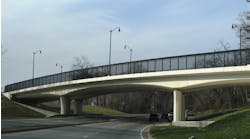The demand for recycled construction materials has risen sharply in the past decade as public interest in and demand for sustainable construction practices has increased.
Recycled concrete aggregate (RCA) can help meet sustainability practices in construction as a replacement for virgin aggregates in new concrete. However, the durability of RCA in new construction must be ensured. RCA can reduce the need to mine virgin aggregates, decrease aggregate transportation distances and reduce the amount of material sent to construction and demolition landfills. A review in 2003 by the Federal Highway Administration (FHWA) showed that, in the U.S., 41 state departments of transportation (DOTs) recycled concrete into aggregates. However, most of those states only utilized RCA in general fill or base aggregate applications. The report stated that of those 41, only 11 state DOTs used RCA as a replacement for virgin aggregates in new concrete. Recent research has proven that the mechanical properties of concrete containing RCA can be sufficient for use in new concrete; however, its use is still limited by the lack of research regarding its long-term durability and a general perception that RCA is a substandard material. Specifically of concern to DOTs interviewed as part of the FHWA study was the durability of concrete when incorporating RCA that comes from sources that were demolished due to deterioration from alkali-silica reaction (ASR).
ASR is a leading cause of concrete deterioration worldwide. Mitigation options for ASR include the incorporation of supplementary cementitious materials (SCMs) and/or lithium nitrate into the fresh concrete mixture.
Previous research has shown that RCA coming from concrete affected by ASR can be reactive when incorporated into new concrete. No comprehensive study, however, has been completed to determine whether current test methods can be applied to accurately determine the reactivity of RCA. A study was conducted at Oregon State University to examine the performance of new concrete incorporating RCA affected by ASR. Phase I examined the applicability of a standard test for classifying an aggregate’s potential to cause ASR, ASTM C 1260 (commonly known as the accelerated mortar bar test [AMBT]); and Phase II examined the potential for SCMs to mitigate the ASR.
Looking at eight
The RCA used in this study came from eight different sources that were affected by ASR. More information on these aggregates can be seen in Table 1.
The tests conducted in Phase I of this study conformed to ASTM C 1260, which indicates an aggregate’s potential ASR through the expansion of mortar bars created from that aggregate. In this test mortar, prisms that measure 1 x 1 x 11.25 in. were cast at a fine aggregate-to-cement ratio of 2.75:1 and a w/cm of 0.47. A stainless steel gauge stud was cast into both ends of each bar to provide an effective 10.00±0.10 in. gauge length. After curing for 24±2 hours in 95% or higher relative humidity and 73±3°F, the mortar bars were submerged in tap water and placed in a 176±3.6°F oven where they equilibrated before the next reading. The initial, or zero, reading of the bars was taken 24±2 hours later, and the bars were quickly transferred to a solution of 1 N NaOH, which was already at 176±3.6°F. The bars then remained in 1 N NaOH at 176±3.6°F for a period of 14 days. Several measurements were taken throughout this time period at approximately the same time each day. Length change was recorded to the nearest 0.0001 in. and results were presented for the average of three prisms to the nearest 0.01%. It is important to note that this test is only applicable to mortar, so the RCA needed to be crushed down to the appropriate gradation required by the test (all particles less than 0.187 in. diameter). The ASTM C 1260 test does not currently account for the total water content to correct for the absorption capacity of the aggregate (aggregates are always mixed in an oven dry state); however, due to the relatively high absorption capacity of the RCA (when compared to virgin aggregates) the test was modified to include additional water to account for the aggregate’s absorption capacity. Specimens were cast at replacement levels for a nonreactive fine aggregate at 100% RCA, 50% RCA and 25% RCA.
Expansion criteria for this test fall into three categories within ASTM C 1260 based on expansion measured 16 days after casting (14 days after immersion in 1 N NaOH). Expansion of less than 0.10% is generally considered to be indicative of innocuous behavior. Expansions of more than 0.20% indicate that the aggregates are potentially deleterious. Expansions that fall between 0.10% and 0.20% indicate that the aggregate may exhibit either innocuous or deleterious performance in the field. The above expansion criteria, as described in ASTM C 1260, are not actually used by many researchers or agencies, but rather, the consensus among many ASR researchers and engineers is to use an expansion limit of 0.10% after 14 days of immersion in the soak solution to indicate aggregate reactivity. Thus, in this study, expansions at or above 0.10% were considered to indicate deleterious expansion due to ASR.
Phase II followed the ASTM C 1567 test method, which is similar to the ASTM C 1260 test; however, the mixture involves replacement of the cement with SCMs at varying levels. The SCMs used in this study were a Class F fly ash, silica fume and metakaolin.
Looking at expansion
Phase I was completed to determine whether the accelerated mortar bar test method used in ASTM C 1260 was able to detect reactivity of RCA. Figure 1 shows the expansion of the Jo-R RCA mortar bars up to 14 days after initial submersion in 1 N NaOH solution at 25%, 50% and 100% replacement levels.
The results indicate that the Jo-R RCA resulted in expansion. However, at 14 days, only the 100% replacement level had exceeded the 0.10% expansion level to be classified as potentially deleterious. The increase in expansion as the replacement level (from 25% to 50% to 100%) increased may be expected due to an increase in reactive material; though, as will be shown later, further research has shown that this is not always the case. Figure 2 shows the expansion results for all eight RCA at each of the replacement levels at 14 days after submersion in 1 N NaOH solution.
These results show that an increase in expansion generally correlated with an increase in replacement level for the tested aggregates. The RCA is a two-phase material consisting of the original aggregate and the adhered mortar. Thus, as the replacement level of RCA increased in a concrete mixture, the amount of reactive original aggregate also increased, which caused the increase in expansion seen here. The St-R expansions, however, do not correlate with an increase in RCA replacement level. The smaller amount of RCA (and thus reactive original aggregate) could have created a pessimum effect, which is where maximum expansions actually occur with less reactive aggregate in the mixture. Further testing is required to confirm whether this was actually a pessimum effect. This shows, however, that at all replacement levels, testing is required to ensure that the reactivity of an RCA is accurately characterized.
These results also show that five of these aggregates would be considered potentially deleterious when compared with the 0.10% expansion limit used by many engineers and agencies; and that three of the aggregates would be considered innocuous when used at a 100% replacement level. Not included as part of this study, however, was whether the expansion criteria to classify an aggregate as reactive or not is applicable to RCA. Further research needs to be completed to verify whether the expansions shown in the ASTM C 1260 accelerated mortar bar test correlate with deleterious expansions in longer-term laboratory tests (ASTM C 1293), outdoor exposure block testing and field concrete. The results do demonstrate, however, that the ASTM C 1260 test can detect the potential for deleterious ASR and can distinguish between varying reactivity levels in ASTM C 1260.
Once Phase I confirmed that ASTM C 1260 could be used to detect the potential for alkali silica-related reactivity in mortar containing RCA, the next step was to see if the reactivity could be mitigated using standard techniques. Phase II of this study was performed to determine whether SCMs could be used to reduce the expansion caused by reactive RCA. Studies were done using the Ca-R at a 100% RCA replacement level. This was tested with binary blends of ordinary portland cement and a Class F fly ash (10.2% CaO content) and ternary blends of an ordinary portland cement, Class F fly ash (10.2% CaO content) and metakaolin or silica fume. Figure 3 shows the results of these mixtures.
These results show that the expansions of the Ca-R RCA were reduced significantly with the use of SCMs as a replacement for a portion of the ordinary portland cement. The 40% Class F fly ash and 50% Class F fly ash binary blends, as well as the 25% Class F fly ash + 10% metakaolin ternary blend, reduced the expansions due to ASR below the 0.10% expansion limit, with the fly ash and metakaolin ternary blend performing the best. These results confirm that it is possible to mitigate ASR of reactive RCA using SCMs according to ASTM C 1567. However, as in Phase I, further work using ASTM C 1293, outdoor exposure block testing and correlation to field performance is necessary to benchmark this accelerated laboratory test method for RCA.
Safe to use
Recycled concrete aggregates are a feasible way to reduce the environmental impact of construction practices. Using RCA will reduce the environmental costs of mining and transporting virgin aggregates, and it will do this while reducing the amount of material sent to landfills which can be costly from both an economic and environmental point of view. The results presented herein demonstrate that RCA, even that which comes from sources affected by ASR, could feasibly be used in new construction provided a few guidelines are followed:
Proper testing and classification of aggregates is performed to determine ASR potential;
Testing is performed on all potential replacement levels used to discover possible pessimum effects; and
Proper levels of mitigation, such as those investigated here, are used to reduce the deleterious effects of ASR on new concrete.
Though this work shows promise for the feasibility of using ASR-affected RCA, further research is still required to be able to completely classify the reactivity and field performance of concrete made with ASR-affected RCA. This would include:
Testing of RCA and monitoring expansions in field exposure blocks;
Correlation of ASTM C 1260 and ASTM C 1567 results with ASTM C 1293, outdoor exposure block testing and field performance; and
Understanding whether the mechanism through which ASR occurs in RCA is the same as that for virgin aggregates. R&B
Acknowledgements
This project was performed under funding from the Oregon Transportation Research and Education Consortium. Thank you to Medhat Shehata, Benoit Fournier, Jennifer Tanner and Angela Jones for assistance in data and material collection. Thank you to Ben Sohn and Brian Grey, undergraduate laboratory assistants at Oregon State University.


